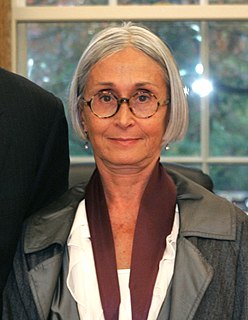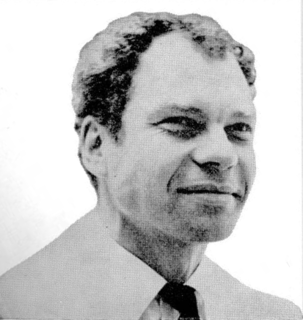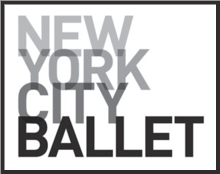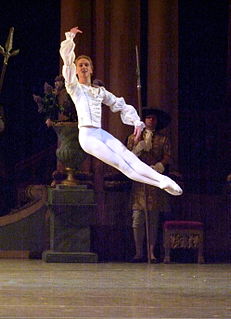Related Research Articles

Twyla Tharp is an American dancer, choreographer, and author who lives and works in New York City. In 1966 she formed the company Twyla Tharp Dance. Her work often uses classical music, jazz, and contemporary pop music.

Mercier Philip "Merce" Cunningham was an American dancer and choreographer who was at the forefront of American modern dance for more than 50 years. He was notable for frequent collaboration with artists of other disciplines, including musicians John Cage, David Tudor, Brian Eno, and graphic artists Robert Rauschenberg, Bruce Nauman, Andy Warhol, Roy Lichtenstein, Frank Stella, and Jasper Johns; and fashion designer Rei Kawakubo. Works that he produced with these artists had a profound impact on avant-garde art beyond the world of dance.

New York City Ballet (NYCB) is a ballet company founded in 1948 by choreographer George Balanchine and Lincoln Kirstein. Balanchine and Jerome Robbins are considered the founding choreographers of the company. Léon Barzin was the company's first music director. City Ballet grew out of earlier troupes: the Producing Company of the School of American Ballet, 1934; the American Ballet, 1935, and Ballet Caravan, 1936, which merged into American Ballet Caravan, 1941; and directly from the Ballet Society, 1946.

Arrested Development is an American hip hop group that formed in Atlanta in 1988. It was founded by Speech and Headliner as a positive, Afrocentric alternative to the gangsta rap popular in the late 1980s. Baba Oje and frontman Speech met at the University of Wisconsin–Milwaukee when they were both students. Baba Oje was 57 years old at the time.
The National Ballet of Canada is a Canadian ballet company that was founded in 1951 in Toronto, Ontario, with Celia Franca as the first artistic director. A company of 70 dancers with its own orchestra, the National Ballet has been led since 2005 by artistic director Karen Kain, one of the greatest ballerinas of her generation. Renowned for its diverse repertoire, the company performs traditional full-length classics, embraces contemporary work and encourages the creation of new ballets as well as the development of Canadian choreographers.
The Australian Ballet is the largest classical ballet company in Australia. It was founded by J. C. Williamson Theatres Ltd. and the Australian Elizabethan Theatre Trust in 1962, with the English-born dancer, teacher, repetiteur and director Dame Peggy van Praagh as founding artistic director. Today, it is recognised as one of the world's major international ballet companies.

Oregon Ballet Theatre (OBT) is a ballet company in Portland, Oregon, United States. The company performs an annual five-program season at the Portland Center for the Performing Arts and conducts regional and national tours. It was featured in the October/November 2007 issue of Pointe magazine, with principal dancer Kathi Martuza on the cover.
Neil Geoffrey Armfield is an Australian director of theatre, film and opera.

Australian Dance Theatre (ADT), known as Meryl Tankard Australian Dance Theatre 1993–1999, is a contemporary dance company based in Adelaide, South Australia, established in 1965 by Dr. Elizabeth Cameron Dalman OAM. The ADT was the first modern dance company in Australia and drew on the techniques of Martha Graham for its inspiration. Eleo Pomare was an early collaborator and the songs of Peter, Paul and Mary featured strongly in their early works, such as This Train.
Ceremonial dancing has a very important place in the Indigenous cultures of Australia. They vary from place to place, but most ceremonies combine dance, song, rituals and often elaborate body decorations and costumes. The different body paintings indicate the type of ceremony being performed. They play an important role in marriage ceremonies, in the education of Indigenous children, as well as story telling and oral history. The term corroboree is commonly used to refer to Australian Aboriginal dances, although this term has its origins among the people of the Sydney region. In some places, Aboriginal people perform corroborees for tourists. In the latter part of the 20th century the influence of Indigenous Australian dance traditions has been seen with the development of concert dance, with the Aboriginal Centre for the Performing Arts (ACPA) providing training in contemporary dance.

Theatre of Australia refers to the history of the performing arts in Australia, or produced by Australians. There are theatrical and dramatic aspects to a number of Indigenous Australian ceremonies such as the corroboree. During its colonial period, Australian theatrical arts were generally linked to the broader traditions of English literature and to British and Irish theatre. Australian literature and theatrical artists have over the last two centuries introduced the culture of Australia and the character of a new continent to the world stage.
The Washington Ballet (TWB) is an ensemble of professional ballet dancers based in Washington DC. It was founded in 1976 by Mary Day, and has been under the artistic directorship of Julie Kent since 2016. Septime Webre was artistic director for 17 years starting in 1999 and stepped down as artistic director at the conclusion of the 2015/2016 season.

The Alvin Ailey American Dance Theater (AAADT) is a modern dance company based in New York City. It was founded in 1958 by choreographer and dancer Alvin Ailey. It is made up of 32 dancers, led by artistic director Robert Battle and associate artistic director Matthew Rushing.
The Royal New Zealand Ballet is a ballet company based in Wellington, New Zealand. It was originally known as The New Zealand Ballet Company.
The APRA Music Awards in Australia are annual awards to celebrate excellence in contemporary music, which honour the skills of member composers, songwriters, and publishers who have achieved outstanding success in sales and airplay performance.

David Hallberg (born 1982} is an American classical ballet dancer. He is a principal dancer with American Ballet Theatre and resident guest artist at The Australian Ballet, and formerly a principal dancer with the Bolshoi Ballet. In 2021 he will take over as artistic director of The Australian Ballet.
Lucy Mary Guerin is an Australian dancer and choreographer. Her work is described as post-modern.

Carriageworks is a multi-arts urban cultural precinct located at the at the former Eveleigh Railway Workshops in, Redfern, Sydney, Australia. Carriageworks showcases contemporary art and performing arts, as well as being used for filming, festivals, fairs and commercial exhibitions. The largest such venue in Australia, it is a cultural facility of the NSW Government, and receives support from Create NSW and the Australian Government through the Australia Council for the Arts. The centre has commissioned new work by Australian and international artists, and has been home to eight theatre, dance and film companies, including Performance Space, Sydney Chamber Opera and Moogahlin Performing Arts, and a weekly farmers' market has operated there for many years.

Greensboro Ballet is a professional ballet company in North Carolina. It is the only ballet company in the Piedmont Triad. It is one of the only non-profit ballet companies in North Carolina. Greensboro Ballet has presented works by George Balanchine. The company also has performed a number of works made especially for the Greensboro Ballet by Rick McCullough, Jill Eathorne Bahr, Leslie Jane Pessemier, and alumni Emery LeCrone. Maryhelen Mayfield, who served as artistic and executive director of Greensboro Ballet from 1980 to 2019, choreographed over twenty-five works for the company.

The COVID-19 pandemic has had a significant impact on the performing arts, mirroring its impacts across all arts sectors. Due to physical distancing requirements and closure of the physical venues, curtailing not only public performances but also rehearsals, many performing arts institutions attempted to adapt by offering new digital services. In particular this resulted in the free online streaming of previously recorded performances of many companies – especially orchestral performances and plays – lists of which were collated by journalists as well as bespoke crowdsourcing projects.
References
- 1 2 Crampton, Hilary (2006-05-31). "Dance Works closes". The Age. Retrieved 2020-09-20.
- ↑ "Dance Works". www.ausstage.edu.au. Retrieved 2020-09-20.